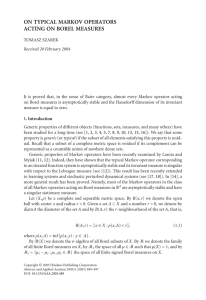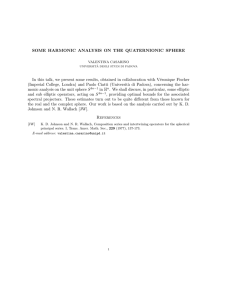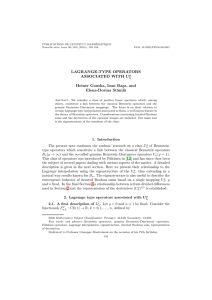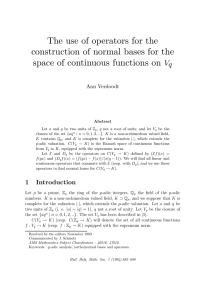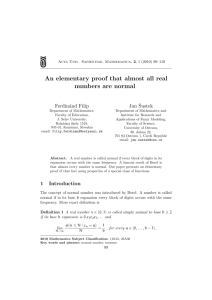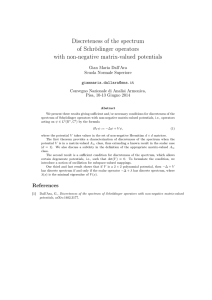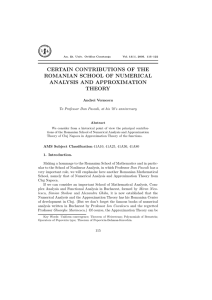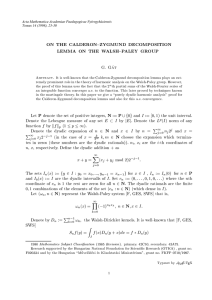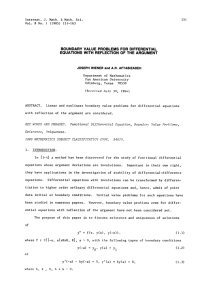58 (2006), 19–29 DIRECT AND INVERSE THEOREMS FOR SZ ˆ ASZ-LUPAS TYPE
advertisement
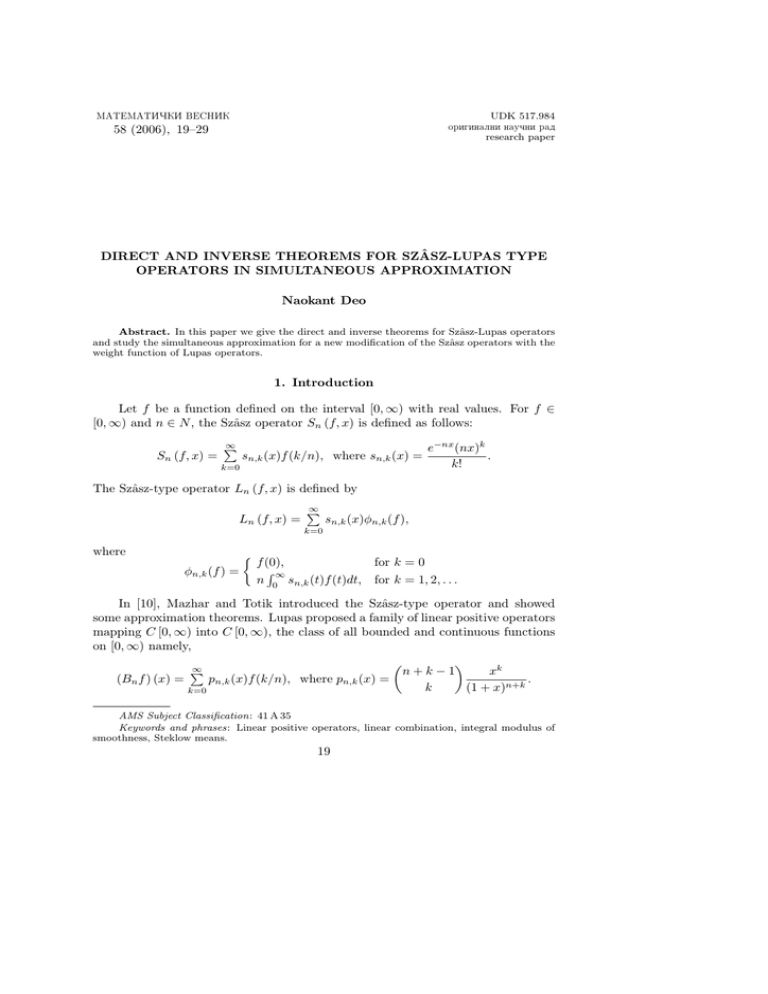
UDK 517.984
originalni nauqni rad
research paper
MATEMATIQKI VESNIK
58 (2006), 19–29
DIRECT AND INVERSE THEOREMS FOR SZÂSZ-LUPAS TYPE
OPERATORS IN SIMULTANEOUS APPROXIMATION
Naokant Deo
Abstract. In this paper we give the direct and inverse theorems for Szâsz-Lupas operators
and study the simultaneous approximation for a new modification of the Szâsz operators with the
weight function of Lupas operators.
1. Introduction
Let f be a function defined on the interval [0, ∞) with real values. For f ∈
[0, ∞) and n ∈ N , the Szâsz operator Sn (f, x) is defined as follows:
Sn (f, x) =
∞
sn,k (x)f (k/n), where sn,k (x) =
k=0
e−nx (nx)k
.
k!
The Szâsz-type operator Ln (f, x) is defined by
Ln (f, x) =
∞
sn,k (x)φn,k (f ),
k=0
where
φn,k (f ) =
f (0),
∞
n 0 sn,k (t)f (t)dt,
for k = 0
for k = 1, 2, . . .
In [10], Mazhar and Totik introduced the Szâsz-type operator and showed
some approximation theorems. Lupas proposed a family of linear positive operators
mapping C [0, ∞) into C [0, ∞), the class of all bounded and continuous functions
on [0, ∞) namely,
∞
n+k−1
xk
pn,k (x)f (k/n), where pn,k (x) =
.
(Bn f ) (x) =
k
(1 + x)n+k
k=0
AMS Subject Classification: 41 A 35
Keywords and phrases: Linear positive operators, linear combination, integral modulus of
smoothness, Steklow means.
19
20
N. Deo
Motivated by the integration of Bernstein polynomials of Derriennic [4], Sahai
and Prasad [11] modified the operators Bn for function integrable on [0, ∞) as
∞
∞
pn,k (x)
pn,k (t)f (t) dt.
(Mn f ) (x) = (n − 1)
0
k=0
Now we consider another modification of operators with the weight function
of Lupas operators, which are defined as
∞
∞
sn,k (x)
pn,k (t)f (t) dt.
(1.1)
(Vn f ) (x) = (n − 1)
k=0
The norm .Cα on the space Cα [0, ∞) =
α > 0 and K > 0} is defined by
f = sup
Cα
0≤t<∞
0
{f ∈ C [0, ∞) : f (t) ≤ Ktα for some
f (t) t−α .
To improve the saturation order O(n−1 ) for the operator (1.1), we use the
technique of linear combination as described below:
Vn (f, k, x) =
where
C(j, x) =
k
i=0
i=j
k
j=0
C(j, k)Vdj n (f, x),
dj
for k = 0 and C(0, 0) = 1
dj − di
and d0 , d1 , d2 , . . . , dk are (k+1) arbitrary, fixed and distinct positive integers. For
our convenience we shall write the operator (1.1) as
∞
W (n, x, t)f (t) dt,
Vn (f, x) =
0
where
W (n, x, t) = (n − 1)
∞
sn,k (x)pn,k (t).
k=0
The function f is said to belong to the generalized Zygmund class Liz (α, k, a, b)
if there exists a constant M such that
ω2k (f, η, a, b) ≤ M η αk , η > 0,
where ω2k (f, η, a, b) denotes the modulus of continuity of 2k-th order of f (x) on the
interval [a, b]. The class Liz (α, 1, a, b) is more commonly denoted by Lip*(α, a, b).
Let f ∈ Cα [0, ∞) and 0 < a1 < a2 < a3 < b3 < b2 < b1 < ∞. Then for m ∈ N
the Steklov mean fη,m of the m-th order corresponding to f , for sufficiently small
values of η > 0 is defined by
η/2 m m
−m
m−1 m
f (x)
dxi ,
(1.2)
f (x) + (−1)
fη,m (x) = η
m
−η/2
where x ∈ [a1 , b1 ] and
length η.
m
η f (x)
i=1
xi
i=1
is the m-th order forward difference with step
Theorems for Szâsz-Lupas type operators
21
The direct results in ordinary and simultaneous approximation for such type
of modified Szâsz-Mirakyan operators were studied by many researchers see e.g. [2],
[5], [6] and [12].
2. Auxiliary results
In this section, we shall give some basic results, which will be useful in proving
the main results.
Lemma 2.1. [9] For m ∈ N ∪ {0}, let the m-th order moment for the Szâsz
operator be defined by
m
∞
k
−x
sn,k (x)
.
µn,m (x) =
n
k=0
Then we have µn,0 (x) = 1, µn,1 (x) = 0 and
nµn,m+1 (x) = x µn,m (x) + mµn,m−1 (x) , for n ∈ N.
Consequently,
(i) µn,m (x) is a polynomial in x of degree [m/2];
(ii) for every x ∈ [0, ∞) , µn,m (x) = O n−[(m+1)/2] , where [β] denotes the
integral part of β.
Lemma 2.2. Let the m-th moment for the Szâsz operator be defined by
∞
∞
sn,k (x)
pn,k (t)(t − x)m dt.
µn,m (x) = (n − 1)
0
k=0
Then
(i) µn,0 (x) = 1, µn,1 (x) =
(1+2x)
(n−2) ,
n > 2;
(ii) (n − m − 2)µn,m+1 (x) = x µn,m (x) + m(2 + x)µn,m−1 (x) + (m + 1) ×
(1 + 2x)µn,m (x)
(iii) µn,m (x) = O n−[(m+1)/2] for all x ∈ [0, ∞).
Proof. By the definition of µn,m (x), we can easily obtain (i). Now the proof of
(ii) goes as follows:
∞
∞
xsn,k (x)
pn,k (t)(t − x)m dt − mxµn,m−1 (x).
xµn,m (x) = (n − 1)
0
k=0
Using relations t(1+t)pn,k (t) = (k −nt)pn,k (t) and xsn,k (x) = (k −nx)sn,k (x),
we get
x µn,m (x) + mµn,m−1 (x)
∞
∞
(k − nx) sn,k (x)
pn,k (t)(t − x)m dt
= (n − 1)
k=0
0
22
N. Deo
= (n − 1)
= (n − 1)
= (n − 1)
∞
k=0
∞
k=0
∞
sn,k (x)
0
0
sn,k (x)
sn,k (x)
k=0
∞
0
∞
∞
[(k − nt) + n (t − x)] pn,k (t)(t − x)m dt
t (1 + t) pn,k (t)(t − x)m dt + nµn,m+1 (x)
(1 + 2x)(t − x) + (t − x)2 + x(1 + x) pn,k (t)(t − x)m dt
+ nµn,m+1 (x)
= −(m + 1)(1 + 2x)µn,m (x) − (m + 2)µn,m+1 (x) − mx(1 + x)µn,m−1 (x)
+ nµn,m+1 (x)
This leads to proof of (ii). The proof of (iii) easily follows from (i) and (ii).
have
Lemma 2.3. If f is differentiable r times (r = 1, 2, 3, . . . ) on [0, ∞), then we
∞
∞
nr (n − r − 1)! sn,k (x)
pn,k (t)f (r) (t) dt.
Vn(r) f (x) =
(n − 2)!
k=0
0
Proof. By Leibnitz’s theorem in (1.1)
r ∞
r (−1)r−i ni e−nx (nx)k−i ∞
(r)
Vn f (x) = (n − 1)
pn,k (t)f (t) dt
(k − 1)!
i=0 k=i i
0
∞
∞ r
r r
(−1)r−i
pn,k+i (t)f (t) dt
n sn,k (x)
= (n − 1)
i
k=0 i=0
0
r ∞
∞
r
sn,k (x)
(−1)r
(−1)i nr pn,k+i (t)(t) f (t) dt.
= (n − 1)
i=0 i
k=0
0
Again using Leibnitz’s theorem
r
r
(n − 1)! (−1)i
pn,k+i (t),
i
(n − r − 1)! i=0
∞
∞
nr (n − r − 1)! (r)
Vn(r) f (x) =
sn,k (x)
(−1)r pn−r,k+r (t)f (t) dt,
(n − 2)!
k=0
0
(r)
pn−r,k+r (t) =
integrating by parts r times, we get the required result.
Lemma 2.4. For the function fη,m (x) defined in (1.2), there hold:
(i) fη,m ∈ C[a1 , b1 ];
(r) (ii) fη,m C[a ,b ] ≤ Mr η −r ωr (f, η, a1 , b1 ), r = 1, 2, . . . , m;
2 2
(iii) f − fη,m C[a2 ,b2 ] ≤ Mm+1 ωm (f, η, a1 , b1 );
(iv) fη,m C[a ,b ] ≤ Mm+2 f C[a ,b ] ≤ M f C ,
2
2
2
2
α
where Mi are certain constants independent of f and η.
For the proof of the above properties of the function fη,m (x) we refer to [12,
page 167].
23
Theorems for Szâsz-Lupas type operators
Lemma 2.5. [8, 9] There exist polynomials qi,j,r (x) independent of n and k
such that
j
dr xr r e−nx (nx)k =
ni k − nx qi,j,r (x) e−nx (nx)k
dx
2i+j≤r
i,j≥0
Lemma 2.6. Let f ∈ Cα [0, ∞). If f (2k+2) exists at a point x ∈ (0, ∞), then
lim nk+1 {Vn (f, k, x) − f (x)} =
n→∞
2k+2
Q(p, k, x)f (p) (x),
p=0
where Q(p, k, x) is a certain polynomial in x of degree p.
The proof of Lemma 2.6 follows along the lines of [7].
Lemma 2.7. Let δ and γ be any two positive numbers and [a, b] ⊂ [0, ∞).
Then, for any m > 0 there exists a constant Mm such that
γ V
(f,
x)t
dt
≤ Mm n−m .
n
|t−x|≥δ
C[a,b]
The proof of this result follows easily by using Schwarz inequality and Lemma
2.7 from [1].
3. Main results
Theorem 3.1. (Direct Theorem) Let f ∈ Cα [0, ∞). Then, for sufficiently
large n, there exists a constant M independent of f and n such that
−1/2
−(k+1) Vn (f, k, .) − f f Cα ,
≤
max
C
ω
(f
;
n
,
a
,
b
)C
n
1
2k+2
1
1
2
C[a2 ,b2 ]
where C1 = C1 (k) and C2 = C2 (k, f ).
Proof. By linearity property
Vn (f, k, .) − f ≤ Vn ((f − f2k+2,η ) , k, .) C[a2 ,b2 ]
C[a2 ,b2 ]
+ Vn (f2k+2,η , k, .) − f2k+2,η C[a ,b ] + f − f2k+2,η C[a
2
2 ,b2 ]
2
= A1 + A2 + A3 ,
By property (iii) of Steklov mean, we get
A3 ≤ C1 ω2k+2 (f, η, a1 , b1 ).
Next, by Lemma 2.6, we get
A2 ≤ C2 n−(k+1) f2k+2,η C[a
1 ,b1 ]
.
say.
24
N. Deo
Using the interpolation property [5] and properties of Steklov mean,
A2 ≤ C3 n−(k+1) f Cα + η −(2k+2) ω2k+2 (f, η) .
To estimate A1 , we choose a2 , b2 such that
0 < a1 < a2 < a3 < b3 < b2 < b1 < ∞.
Also let ψ(t) be the characteristic function of the interval [a2 , b2 ], then
A1 ≤ Vn (ψ(t) (f (t) − f2k+2,η (t)) , k, .) C[a ,b ]
3 3
+ Vn ((1 − ψ(t)) (f (t) − f2k+2,η (t)) , k, .) C[a3 ,b3 ]
= A4 + A5 ,
say.
We note that in order to estimate A4 and A5 , it is sufficient to consider their
expressions without the linear combination. It is clear that by Lemma 2.3, we
obtain
Vn (ψ(t) (f (t) − f2k+2,η (t)) , x)
∞
sn,k (x)
= (n − 1)
k=0
Hence,
∞
0
Vn (ψ(t) (f (t) − f2k+2,η (t)) , .) C[a
1 ,b1 ]
pn,k (t)ψ(t) (f (t) − f2k+2,η (t)) dt.
≤ C4 f − f2k+2,η C[a
2 ,b2 ]
.
Now
for x ∈ [a3 , b3 ] and t ∈ [0, ∞) / [a2 , b2 ] we can choose an η1 satisfying
t − x ≥ η1 . Therefore by Lemma 2.5 and Schwarz inequality, we have
I ≡ Vn ((1 − ψ(t)) (f (t) − f2k+2,η (t)) , x) φi,j,r (x) ∞
j
i
≤ (n − 1)
n
sn,k (x)k − nx ×
r
x
2i+j≤r
k=0
i,j≥0
∞
×
pn,k (t) (1 − ψ(t)) f (t) − f2k+2,η (t) dt
0
∞
j
i
≤ C5 f C (n − 1)
n
sn,k (x) k − nx
pn,k (t) dt
α
2i+j≤r
i,j≥0
|t−x|≥η1
k=0
∞
j
ni
sn,k (x)k − nx ×
≤ C5 η1−2s f C (n − 1)
α
×
≤
0
2i+j≤r
i,j≥0
k=0
1/2 ∞
pn,k (t) dt
C5 η1−2s f C
α
2i+j≤r
i,j≥0
i
n
0
∞
pn,k (t)(t − x)4s dt
2j
1/2
1/2
sn,k (x)(k − nx)
×
k=0
∞
sn,k (x)
× (n − 1)
k=0
∞
∞
0
pn,k (t)(t − x)4s dt
1/2
.
25
Theorems for Szâsz-Lupas type operators
Hence, by Lemma 2.1 and Lemma 2.2, we have
j
I ≤ C6 f Cα n(i+ 2 −s) ≤ C6 n−q f Cα
where q = (s − m/2).
I ≤ C6 n−(k+1) f Cα .
Now choose s > 0 such that q ≥ k + 1.
Then
Therefore by property (iii) of Steklov mean, we get
A1 ≤ C7 f − f2k+2,η C[a ,b ] + C6 n−(k+1) f C
2 2
α
−(k+1) f C
≤ C8 ω2k+2 (f, η, a1 , b1 ) + C6 n
α
Hence with η = n
−1/2
, the theorem follows.
Theorem 3.2. (Inverse Theorem) If 0 < α < 2 and f ∈ Cα [0, ∞) then in
the following statements (i) ⇒ (ii):
(i) Vn (f, k, x) − f (x)C[a ,b ] = O n−α(k+1)/2 , where f ∈ Cα [a, b],
1
1
(ii) f ∈ Liz(α, k + 1, a2 , b2 ).
Proof. Let us choose points a , a , b , b in such a way that a1 < a < a <
a2 < b2 < b < b < b1 . Also suppose g ∈ C0∞ with supp(g) ⊂ [a , b ] and g(x) = 1
for x ∈ [aa , b2 ]. It is sufficient to show that
Vn (f g, k, .) − f g = O n−α(k+1)/2 ⇒ (ii).
(3.1)
C[a ,b ]
Using F in place of f g for all the values of r > 0, we get
2k+2 r
F C[a ,b ] ≤ 2k+2
(F − Vn (F, k, .))C[a ,b ] + 2k+2
Vn (F, k, .)C[a ,b ]
r
r
(3.2)
,
By the definition of 2k+2
r
2k+2
r
Vn (F, k, .) C[a ,b ]
r r 2k+2
=
···
Vn F, k, x +
xi dx1 . . . dx2k+2 i=1
0
0
C[a ,b ]
≤ r2k+2 Vn(2k+2) (F, k, .) C[a ,b +(2k+2)r]
≤ r2k+2 Vn(2k+2) (F − Fη,2k+2 , k, .) C[a ,b +(2k+2)r]
+ Vn(2k+2) (Fη,2k+2 , k, .) C[a ,b +(2k+2)r] , (3.3)
where Fη,2k+2 is the Steklov mean of (2k + 2)-th order corresponding to F . By
Lemma 3 from [1], we get
∞ 2k+2
∂
W
(t,
x)
dt
∂x2k+2 n
0
∞
∞
j qi,j,2k+2 (x)
i
≤
(n − 1)
n k − nx
sn,k (x)
pn,k (t) dt.
x2k+2
2i+j≤2k+2
k=0
0
i,j≥0
26
Since
N. Deo
∞
0
1
n−1 ,
pn,k (t) dt =
∞
by Lemma 2.1,
2j
2j
sn,k (x)(k − nx)
=n
k=0
∞
sn,k (x)
k=0
2j
k
−x
= O(nj )
n
(3.4)
Using Schwarz inequality and Lemma 2.1, we obtain
(2k+2)
Vn
(F − Fη,2k+2 , k, .) C[a ,b +(2k+2)r] ≤ K1 nk+1 F −Fη,2k+2 C[a ,b ] (3.5)
By Lemma 2 from [1], we get
∞ k
∂
W
(t,
x)
(t − x)i dt = 0,
n
k
∂x
0
for k > i.
(3.6)
By Taylor’s expansion, we obtain
Fη,2k+2 (t) =
(i)
2k+1
Fη,2k+2 (x)
i=0
i!
(2k+2)
(t − x)i + Fη,2k+2 (ξ)
(t − x)2k+2
,
(2k + 2)!
(3.7)
where t < ξ < x. By (3.6) and (3.7), we get
∂ 2k+2
2k+2 Vn (Fη,2k+2 , k, .) ∂x
C[a ,b +(2k+2)r]
∞ ∂ 2k+2
k
C(j, k) (2k+2) 2k+2
≤
W
(t,
x)
(t−x)
dt
Fη,2k+2 .
d
n
j
2k+2
(2k
+
2)!
∂x
C[a
,b
]
C[a ,b ]
j=0
0
Again applying Schwarz inequality for integration and summation and Lemma
3 from [1], we obtain
∞ 2k+2
∂
2k+2
dt
I≡
∂x2k+2 Wn (t, x)(t, x)
0
∞
j qi,j,2k+2 (x) ∞
i
≤ (n − 1)
n sn,k (x)k − nx
pn,k (t)(t − x)2k+2 dt
x2k+2
2i+j≤2k+2 k=0
0
i,j≥0
1/2
q
∞
(x) i i,j,2k+2
2j
n
s
(x)(k
−
nx)
×
≤
n,k
x2k+2
2i+j≤2k+2
k=0
i,j≥0
× (n − 1)
∞
sn,k (x)
k=0
∞
0
4k+4
pn,k (t)(t − x)
1/2
dt
.
(3.8)
Using Lemma 2 from [1],
∞
∞
(n − 1)
sn,k (x)
pn,k (t)(t − x)4k+4 dt = Tn,4k+4 (x) = O n−(2k+2) . (3.9)
k=0
0
Using (3.4) and (3.9) in (3.8), we obtain
i qi,j,2k+2 (x)
I≤
n
O(nj/2 )O n−(k+1) = O(1).
k+1
x
2i+j≤2k+2
i,j≥0
27
Theorems for Szâsz-Lupas type operators
Hence
(2k+2)
(2k+2) Wn
(Fη,2k+2 , k, .) C[a ,b +(2k+2)r] ≤ K2 Fη,2k+2 C[a ,b ]
.
(3.10)
On combining (3.2), (3.3), (3.5) and (3.10) it follows
2k+2 r
F C[a ,b ] ≤ 2k+2
(F − Vn (F, k, .)) C[a ,b ]
r
(2k+2) + K3 r2k+2 nk+1 F − Fη,2k+2 C[a ,b ] + Fη,(2k+2) C[a ,b ] .
Since for small values of r the above relation holds, it follows from the properties
of Fη,2k+2 and (3.1) that
ω2k+2 (F, h, [a , b ])
(F, η, [a , b ]) .
≤ K4 n−α(k+1)/2 + h2k+2 nk+1 + η −2k+2 ω
2k+2
Choosing η is such a way that n < η −2 < 2r and following Berens and Lorentz [3],
we obtain
(3.11)
w2k+2 (F, h, [a , b ]) = O(hα(k+1) ).
Since F (x) = f (x) in [a2 , b2 ], from (3.11) we have
w2k+2 (f, h, [a2 , b2 ]) = O(hα(k+1) ), i.e., f ∈ Liz(α, k + 1, a2 , b2 ).
Let us assume (i). Putting τ = α(k + 1), we first consider the case 0 < τ ≤ 1.
For x ∈ [a , b ], we get
Vn (f g, k, x) − f (x)g(x) = g(x)Vn ((f (t) − f (x)) , k, x) +
b1
k
C (j, k)
Wdj ,n (t, x)f (x) (g(t) − g(x)) dt + O n−k+1)
+
j=0
a1
= I1 + I2 + O n−(k+1) ,
(3.12)
where the O-term holds uniformly for x ∈ [a , b ]. Now by assumption
Vn (f, k, .) − f = O n−τ /2 ,
C[a1 ,b1 ]
we have
I1 ≤ g Vn (f, k, .) − f ≤ K5 n−τ /2 .
C[a ,b ]
C[a ,b ]
C[a ,b ]
(3.13)
By the Mean Value Theorem, we get
b1
k
I2 =
C(j, k)
Wdj ,n (t, x)f (t) {g (ξ)(t − x)} dt.
j=0
a1
Once again applying Cauchy-Schwarz inequality and Lemma 2 from [1], we get
k
g I2 ≤ f |C(j,
k)|
×
C[a ,b ]
C[a1 ,b1 ]
× max 0≤j≤k 0
C[a ,b ]
∞
j=0
1/2
Wdj ,n (t, x)(t − x)2 dt
= O n−τ /2 .
C[a ,b ]
Combining (3.12–3.14), we obtain
Vn (f g, k, .) − f g C[a ,b ]
= O n−τ /2 , for 0 < τ ≤ 1.
(3.14)
28
N. Deo
Now to prove the implication for 0 < τ < 2k + 2, it is sufficient to assume it
for τ ∈ (m − 1, m) and prove if for τ ∈ (m, m + 1), (m = 1, 2, 3, . . . , 2k + 1). Since
the result holds for τ ∈ (m − 1, m), we choose two points x1 , y1 in such a way that
a1 < x1 < a < b < y1 < b1 . Then in view of assumption (i) ⇒ (ii) for the interval
(m − 1, m) and equivalence of (ii) it follows that f (m−1) exists and belongs to the
class Lip(1 − δ, x1 , y1 ) for any δ > 0.
Let g ∈ C0∞ be such that g(x) = 1 on [a , b ] and supp g ⊂ [a , b ]. Then with
χ2 (t) denoting the characteristic function of the interval [x1 , y1 ], we have
Vn (f, g, k, .) − f g ≤ Vn (g(x)f (t) − f (x)), k, .) +
C[a ,b ]
C[a ,b ]
+ Vn (f (t)(g(t) − g(x))χ(t), k, .)C[a ,b ] + O n−(k+1) . (3.15)
Now
Vn (g(x)(f (t) − f (x)), k, .) ≤ g Vn (f, k, .) − f C[a ,b ]
C[a ,b ]
C[a1 ,b1 ]
−τ /2
=O n
.
(3.16)
Applying Taylor’s expansion of f , we have
I3 ≡ Vn (f (t)g(t) − g(x))χ(t), k, .)C[a ,b ] =
(m−1)
m−1
f (i) (x)
f
(ξ) − f (m−1) (x) i
(t−x) +
(g(t)−g(x))χ(t), k, . Vn
i!
(m − 1)!
C[a ,b ]
i=0
where ξ lies between t and x. Since f (m−1) ∈ Lip(1 − δ, x1 , y1 ),
1−δ
1−δ
(m−1)
f
(ξ) − f (m−1) (x) ≤ K6 ξ − x
≤ K6 t − x ,
where K6 is the Lip(1 − δ, x1 , y1 ) constant for f (m−1) , we have
m−1 (i)
f (x)
i
V
(t
−
x)
(g(t)
−
g(x))χ(t),
k,
.
I3 ≤ n
i!
i=0
C[a ,b ]
k
K6 C(j, k) Vdj ,n (t − xm+1−δ χ(t), .) g +
C[a
,b
]
C[a ,b ]
(m − 1)!
j=0
= I4 + I5
say.
(3.17)
By Taylor’s expansion of g and Lemma 2.6, we have
I4 = O n−(k+1) .
(3.18)
Also, by Hölder’s expansion of g and Lemma 2 from [1], we have
k
K6 C(j, k) ×
g I5 ≤
C[a ,b ]
(m − 1)!
j=0
y1
t − xm+1−δ dt
× max W
(t
−
x)
d
,n
j
0≤j≤k C[a ,b ]
x1
y1
(m+1−δ)
2(m+1)
2(m+1)
≤ K7 max Wdj ,n (t − x)(t − x)
dt
0≤j≤k
x1
C[a ,b ]
−(m+1−δ)/2
τ /2
=O n
,
=O n
(3.19)
Theorems for Szâsz-Lupas type operators
29
by choosing δ such that 0 < δ < m + 1 − δ. Combining the estimates (3.15–3.19),
we get
Vn (f g, k, .) − f g = O nτ /2 .
C[a ,b ]
This completes the proof of the Theorem 3.2.
Acknowledgment. The author is extremely thankful to the referee for his
valuable comments and suggestions, leading to a better presentation of the paper.
The author is also thankful to Professor Mila Mršević for special attention.
REFERENCES
[1] Agrawal, P. N. and Thamer, K. J., Approximation of unbounded functions by a new sequence
of linear positive operators, J. Math. Anal. Appl., 225 (1998), 660–672.
[2] Agrawal, P. N. and Thamer, K. J., Degree of approximation by a new sequence of linear
operators, Kyungpook Math. J., 41 (2001), 65–73.
[3] Berens, H. and Lorentz, G. G., Inverse theorems for Bernstein polynomials, Indiana Univ.
Math. J., 21 (1972), 693–708.
[4] Derriennic, M. M., Sur l’approximation de functions integrable sur [0, 1] par des polynomes
de Bernstein modifies, J. Approx. Theory, 31 (1981), 325–343.
[5] Goldberg, S. and Meir, V., Minimum moduli of differentiable operators, Proc. London Math.
Soc., 23 (1971), 1–15.
[6] Gupta, V., A note on modified Szâsz operators, Bull Inst. Math. Academia Sinica, 21 (3)
(1993), 275–278.
[7] Gupta, V. and Srivastava, G. S., Simultaneous approximation by Baskakov-Szâsz type operators, Bull. Math. Dela Soc. Sci Math de Roumanie (N. S.), 37 (85) (1993), 73–85.
[8] Gupta, V. and Srivastava, G. S., On the convergence of derivative by Szâsz-Mirakyan
Baskakov type operators, The Math. Student, 64 (1–4) (1995), 195–205.
[9] Kasana, H. S., Prasad, G., Agrawal, P. N. and Sahai, A., Modified Szâsz operators, Conference
on Mathematica Analysis and its Applications, Kuwait, Pergamon Press, Oxford, 1985, 29–
41.
[10] Mazhar, S. M. and Totil, V., Approximation by modified Szâsz operators, Acta Sci. Math.
(Szeged), 49 (1985), 257–269.
[11] Sahai, A. and Prasad, G., On simultaneous approximation by modified Lupas operators, J.
Approx. Theory, 45 (1985), 122–128.
[12] Timan, A. F., Theory of Approximation of Functions of Real Variable (English translation),
Pergamon Press Long Island City, N. Y., 1963.
(received 07.04.2004, in revised form 29.01.2006)
Department of Applied Mathematics, Delhi College of Engineering, Bawana Road, Delhi-110042,
India.
Presently at: School of Information Science and Engineering, Graduate School of the Chinese
Academy of Sciences, No.3 Nanyitiao, Zhongguancun Haidian District, Beijing-100080, P. R.
China.
E-mail: dr naokant deo@yahoo.com

